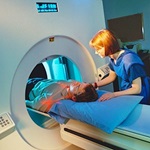Pharmacologic Cardiac Perfusion
 A pharmacologic cardiac perfusion test, also called a nuclear heart scan, checks the blood flow to your heart. This test can detect coronary artery disease (CAD), a blockage in the blood vessels to the heart. It also can show how severe the blockages are. This exam is done most often for patients who should not exercise or have difficulty with exercise.
A pharmacologic cardiac perfusion test, also called a nuclear heart scan, checks the blood flow to your heart. This test can detect coronary artery disease (CAD), a blockage in the blood vessels to the heart. It also can show how severe the blockages are. This exam is done most often for patients who should not exercise or have difficulty with exercise.
The test consists of two separate sets of pictures. The first set is taken when you are at rest, and the second is done after medication is used to briefly change the blood flow to your heart, much the same way exercise would change the blood flow.
The test uses a small amount of two radioactive tracers to show the blood flow (perfusion) to the heart muscle. The amount of radiation used in this test is small and well within limits that are not harmful.
What to expect
Your total test time is three to three-and-a-half hours. Your physician will explain the procedure to you and answer any questions you may have.
Before the test
An IV line is placed in your arm, and you will be given the first tracer, thallium, into the IV. Once the thallium circulates for 15 to 30 minutes, you will be assisted onto an imaging table. You will be asked to lie quietly on your back under the camera for these pictures. The camera will be placed close to your chest. It is very important that you do not move while these pictures are being taken. The camera will take pictures at various angles for about 15 to 30 minutes.
You then will be prepared for the stress portion of your test. After putting on a hospital gown, the skin on your chest will be prepared for electrode (a small pad) placement. The electrodes monitor your heart rhythm during the test.
During the test
You will lie on an imaging table while the IV stress medication infuses over a short period of time. Then, you may be asked to perform mild exercise for a few minutes, such as leg lifts or walking at a very slow pace on a treadmill. A second radioactive tracer is given in your IV at the time of peak stress. During the test, the doctor and staff will closely monitor your blood pressure, heart rate and heart rhythm. Be sure to tell the doctor if you have chest pain, dizziness or headache, feel flushed or have other discomforts.
After the test
After the stress portion of your test, the IV is removed and you may change out of your hospital gown. The radioactive tracer needs to circulate for at least 60 minutes before a second set of pictures is done. You may leave the department during this time and may eat. When you return, you will once again be asked to lie quietly while the pictures are being taken.
